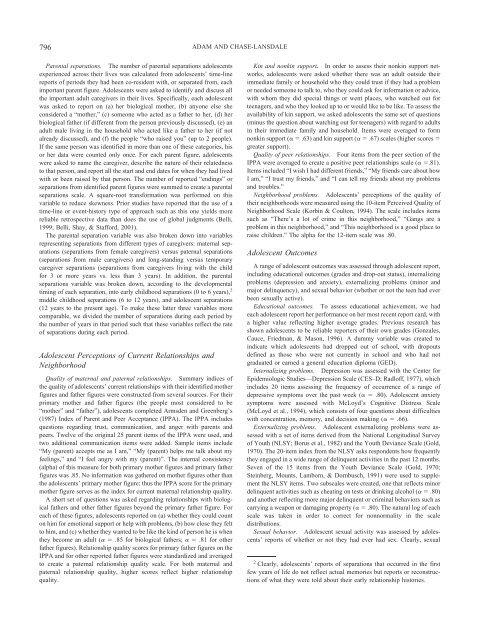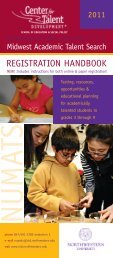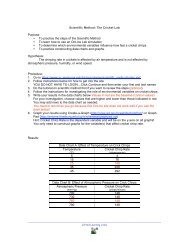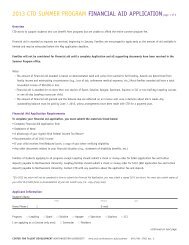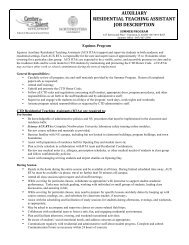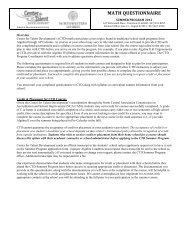Home Sweet Home(s): Parental Separations, Residential Moves ...
Home Sweet Home(s): Parental Separations, Residential Moves ...
Home Sweet Home(s): Parental Separations, Residential Moves ...
- No tags were found...
You also want an ePaper? Increase the reach of your titles
YUMPU automatically turns print PDFs into web optimized ePapers that Google loves.
796 ADAM AND CHASE-LANSDALE<strong>Parental</strong> separations. The number of parental separations adolescentsexperienced across their lives was calculated from adolescents’ time-linereports of periods they had been co-resident with, or separated from, eachimportant parent figure. Adolescents were asked to identify and discuss allthe important adult caregivers in their lives. Specifically, each adolescentwas asked to report on (a) her biological mother, (b) anyone else sheconsidered a “mother,” (c) someone who acted as a father to her, (d) herbiological father (if different from the person previously discussed), (e) anadult male living in the household who acted like a father to her (if notalready discussed), and (f) the people “who raised you” (up to 2 people).If the same person was identified in more than one of these categories, hisor her data were counted only once. For each parent figure, adolescentswere asked to name the caregiver, describe the nature of their relatednessto that person, and report all the start and end dates for when they had livedwith or been raised by that person. The number of reported “endings” orseparations from identified parent figures were summed to create a parentalseparations scale. A square-root transformation was performed on thisvariable to reduce skewness. Prior studies have reported that the use of atime-line or event-history type of approach such as this one yields morereliable retrospective data than does the use of global judgments (Belli,1999; Belli, Shay, & Stafford, 2001).The parental separation variable was also broken down into variablesrepresenting separations from different types of caregivers: maternal separations(separations from female caregivers) versus paternal separations(separations from male caregivers) and long-standing versus temporarycaregiver separations (separations from caregivers living with the childfor 3 or more years vs. less than 3 years). In addition, the parentalseparations variable was broken down, according to the developmentaltiming of each separation, into early childhood separations (0 to 6 years), 2middle childhood separations (6 to 12 years), and adolescent separations(12 years to the present age). To make these latter three variables morecomparable, we divided the number of separations during each period bythe number of years in that period such that these variables reflect the rateof separations during each period.Adolescent Perceptions of Current Relationships andNeighborhoodQuality of maternal and paternal relationships. Summary indices ofthe quality of adolescents’ current relationships with their identified motherfigures and father figures were constructed from several sources. For theirprimary mother and father figures (the people most considered to be“mother” and “father”), adolescents completed Armsden and Greenberg’s(1987) Index of Parent and Peer Acceptance (IPPA). The IPPA includesquestions regarding trust, communication, and anger with parents andpeers. Twelve of the original 25 parent items of the IPPA were used, andtwo additional communication items were added. Sample items include“My (parent) accepts me as I am,” “My (parent) helps me talk about myfeelings,” and “I feel angry with my (parent)”. The internal consistency(alpha) of this measure for both primary mother figures and primary fatherfigures was .85. No information was gathered on mother figures other thanthe adolescents’ primary mother figure; thus the IPPA score for the primarymother figure serves as the index for current maternal relationship quality.A short set of questions was asked regarding relationships with biologicalfathers and other father figures beyond the primary father figure. Foreach of these figures, adolescents reported on (a) whether they could counton him for emotional support or help with problems, (b) how close they feltto him, and (c) whether they wanted to be like the kind of person he is whenthey become an adult ( .85 for biological fathers; .81 for otherfather figures). Relationship quality scores for primary father figures on theIPPA and for other reported father figures were standardized and averagedto create a paternal relationship quality scale. For both maternal andpaternal relationship quality, higher scores reflect higher relationshipquality.Kin and nonkin support. In order to assess their nonkin support networks,adolescents were asked whether there was an adult outside theirimmediate family or household who they could trust if they had a problemor needed someone to talk to, who they could ask for information or advice,with whom they did special things or went places, who watched out forteenagers, and who they looked up to or would like to be like. To assess theavailability of kin support, we asked adolescents the same set of questions(minus the question about watching out for teenagers) with regard to adultsin their immediate family and household. Items were averaged to formnonkin support ( .63) and kin support ( .67) scales (higher scores greater support).Quality of peer relationships. Four items from the peer section of theIPPA were averaged to create a positive peer relationships scale ( .81).Items included “I wish I had different friends,”“My friends care about howI am,” “I trust my friends,” and “I can tell my friends about my problemsand troubles.”Neighborhood problems. Adolescents’ perceptions of the quality oftheir neighborhoods were measured using the 10-item Perceived Quality ofNeighborhood Scale (Korbin & Coulton, 1994). The scale includes itemssuch as “There’s a lot of crime in this neighborhood,” “Gangs are aproblem in this neighborhood,” and “This neighborhood is a good place toraise children.” The alpha for the 12-item scale was .80.Adolescent OutcomesA range of adolescent outcomes was assessed through adolescent report,including educational outcomes (grades and drop-out status), internalizingproblems (depression and anxiety), externalizing problems (minor andmajor delinquency), and sexual behavior (whether or not the teen had everbeen sexually active).Educational outcomes. To assess educational achievement, we hadeach adolescent report her performance on her most recent report card, witha higher value reflecting higher average grades. Previous research hasshown adolescents to be reliable reporters of their own grades (Gonzales,Cauce, Friedman, & Mason, 1996). A dummy variable was created toindicate which adolescents had dropped out of school, with dropoutsdefined as those who were not currently in school and who had notgraduated or earned a general education diploma (GED).Internalizing problems. Depression was assessed with the Center forEpidemiologic Studies—Depression Scale (CES–D; Radloff, 1977), whichincludes 20 items assessing the frequency of occurrence of a range ofdepressive symptoms over the past week ( .80). Adolescent anxietysymptoms were assessed with McLoyd’s Cognitive Distress Scale(McLoyd et al., 1994), which consists of four questions about difficultieswith concentration, memory, and decision making ( .66).Externalizing problems. Adolescent externalizing problems were assessedwith a set of items derived from the National Longitudinal Surveyof Youth (NLSY; Borus et al., 1982) and the Youth Deviance Scale (Gold,1970). The 20-item index from the NLSY asks respondents how frequentlythey engaged in a wide range of delinquent activities in the past 12 months.Seven of the 15 items from the Youth Deviance Scale (Gold, 1970;Steinberg, Mounts, Lamborn, & Dornbusch, 1991) were used to supplementthe NLSY items. Two subscales were created, one that reflects minordelinquent activities such as cheating on tests or drinking alcohol ( .80)and another reflecting more major delinquent or criminal behaviors such ascarrying a weapon or damaging property ( .80). The natural log of eachscale was taken in order to correct for nonnormality in the scaledistributions.Sexual behavior. Adolescent sexual activity was assessed by adolescents’reports of whether or not they had ever had sex. Clearly, sexual2 Clearly, adolescents’ reports of separations that occurred in the firstfew years of life do not reflect actual memories but reports or reconstructionsof what they were told about their early relationship histories.


